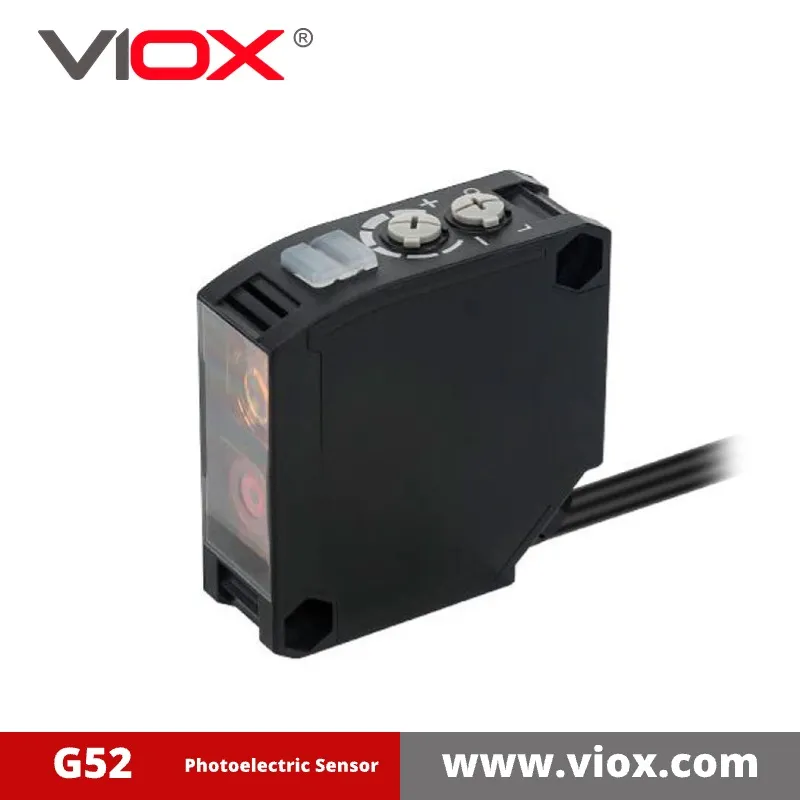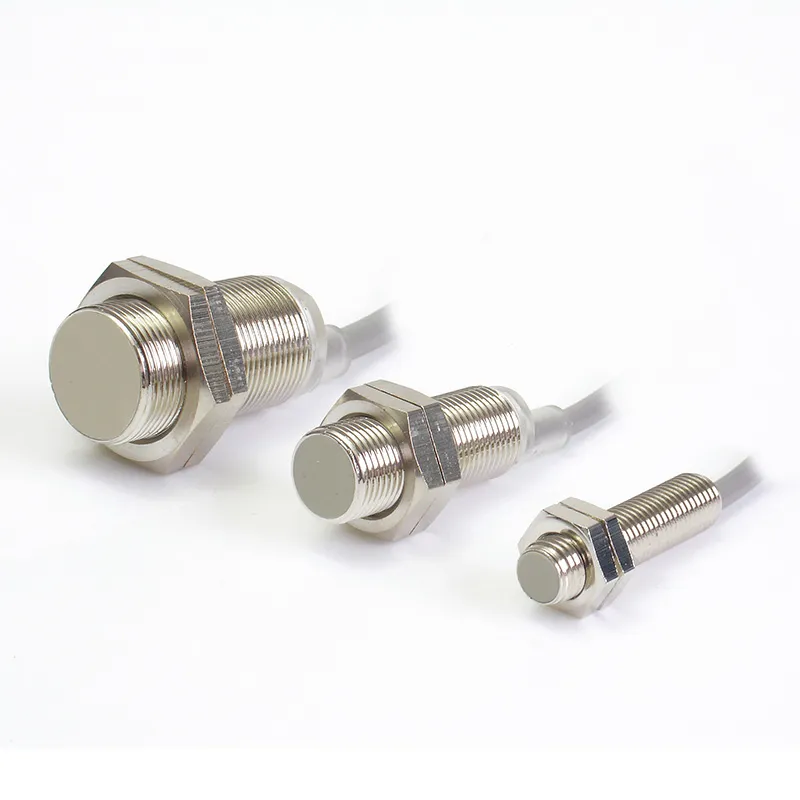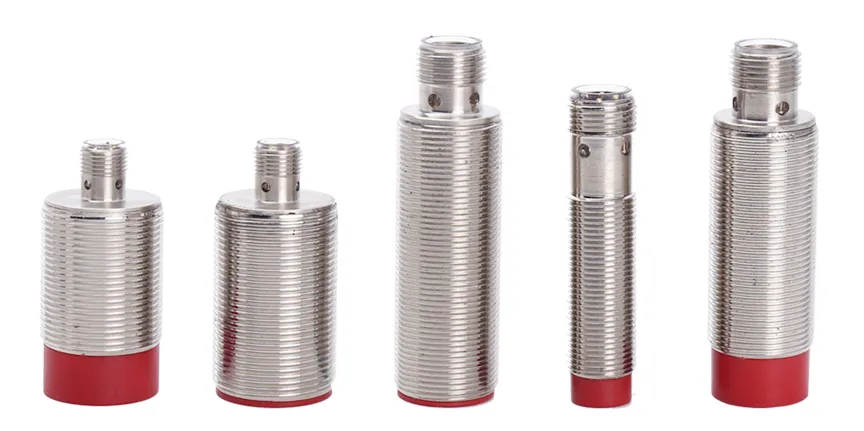I. Introduction to Proximity Sensor Technologies
Proximity sensors are essential devices used to detect the presence or absence of an object within a specified range without physical contact. They operate by emitting various forms of energy—such as electromagnetic fields, sound waves, or light—and measuring the response when an object comes close to the sensor. The diversity in proximity sensor technologies allows for their application in numerous fields, including industrial automation, robotics, automotive systems, and consumer electronics.
II. Capacitive Proximity Sensors
Key Features of Capacitive Proximity Sensors
Capacitive proximity sensors are versatile devices that detect the presence of objects without physical contact. Here are their key features:
- Detection Range: Typically, capacitive sensors can detect objects within a range of a few millimeters up to about 1 inch (25 mm), with some models extending up to 2 inches.
- Material Sensitivity: These sensors can detect both metallic and non-metallic materials, including liquids, plastics, and glass, due to their ability to sense changes in capacitance based on the dielectric constant of the target material.
- Non-contact Operation: They operate without physical contact, which reduces wear and extends the sensor’s lifespan.
- Adjustable Sensitivity: Many capacitive sensors include a potentiometer for adjusting sensitivity, allowing users to fine-tune detection parameters for specific applications.
- LED Indicators: Most models are equipped with LED indicators to visually confirm the sensor’s operational status.
Working Principle
Capacitive proximity sensors function based on the principle of capacitance changes caused by nearby objects. Here’s how they work:
- Construction: The sensor consists of two metal electrodes that form a capacitor. One electrode is connected to an oscillator circuit, while the other acts as a reference plate.
- Capacitance Change: When an object approaches the sensor, it enters the electric field created between the electrodes. This presence alters the dielectric constant between the plates, which in turn changes the capacitance of the system.
- Oscillation Detection: The oscillator circuit detects these changes in capacitance. As an object approaches, the capacitance increases, leading to a change in oscillation frequency of the circuit. This frequency shift is monitored by an amplifier and converted into a binary output signal indicating object presence.
- Output Signal: When the oscillation reaches a certain threshold amplitude, it triggers a change in the output state of the sensor. Conversely, when the object moves away, the amplitude decreases, returning the output to its original state.
- Environmental Considerations: For optimal performance, capacitive sensors should be used in environments with stable temperature and humidity levels, as fluctuations can affect their sensitivity and accuracy.
III. Ultrasonic Proximity Sensors
Advantages of Ultrasonic Proximity Sensors
 Ultrasonic proximity sensors offer several advantages that make them suitable for various applications:
Ultrasonic proximity sensors offer several advantages that make them suitable for various applications:
- Material Independence: They can detect all types of materials, including shiny, transparent, and irregularly shaped objects, without being affected by the object’s color or surface texture.
- Long Detection Range: Ultrasonic sensors can measure distances greater than 1 meter, making them ideal for applications requiring long-range detection.
- Robust Performance in Adverse Conditions: These sensors are not influenced by environmental factors such as dust, rain, or snow, which can hinder other sensor types. Their operation remains reliable even in challenging conditions.
- High Sensitivity and Accuracy: Ultrasonic sensors provide precise measurements and are capable of detecting small objects over considerable distances.
- Versatile Applications: They are widely used in various industries for tasks like level measurement, object detection, and automated process control, proving their adaptability across different scenarios.
Operating Mechanism
The operating mechanism of ultrasonic proximity sensors is based on the emission and reception of high-frequency sound waves. Here’s how they work:
- Sound Wave Emission: The sensor emits ultrasonic sound waves (typically above 20 kHz) towards the target object.
- Reflection: These sound waves travel until they hit an object and are reflected back towards the sensor.
- Time Measurement: The sensor measures the time taken for the emitted sound waves to return after hitting the object. This time interval is crucial for determining the distance to the object.
- Distance Calculation: Using the formula Distance = (Speed of Sound × Time) / 2, the sensor calculates the distance to the object based on the speed of sound in air (approximately 343 meters per second at room temperature) and the measured time.
- Output Signal Generation: Once the distance is calculated, the sensor generates an output signal indicating whether an object is within a predetermined range, allowing for various applications such as triggering alarms or controlling machinery.
IV. Magnetic Proximity Sensors
Types of Magnetic Proximity Sensors
Magnetic proximity sensors can be categorized into several types based on their operating principles and applications:
- Reed Switch: This is a magnetically actuated switch that consists of two ferromagnetic reeds sealed in a glass capsule. When a magnetic field is present, the reeds come together to complete an electrical circuit.
- Hall Effect Sensor: Utilizes the Hall Effect principle, where a voltage is generated across a conductor when it is exposed to a magnetic field. This sensor detects the presence of magnets and provides an output signal accordingly.
- Magnetostrictive Sensor: Measures the position of a magnetic object using the magnetostrictive effect, which involves changes in the magnetic field affecting the properties of a material.
- Magneto-Resistive Sensor: Operates based on the magneto-resistive effect, where the electrical resistance of a ferromagnetic material changes in response to an external magnetic field.
- Inductive Magnetic Proximity Sensor: Similar to inductive sensors but specifically designed to detect magnetic fields rather than metallic objects. They utilize an oscillating coil to generate a magnetic field and detect changes when a permanent magnet approaches.
Functionality
The functionality of magnetic proximity sensors revolves around their ability to detect magnetic fields and provide corresponding output signals. Here’s how they operate:
- Detection Mechanism: Magnetic proximity sensors detect the presence of magnetic objects (like permanent magnets) through various principles, including those mentioned above. Each type has its unique method for sensing:
- Reed Switches close contacts when exposed to a magnetic field.
- Hall Effect Sensors generate a voltage signal in response to nearby magnets.
- Magnetostrictive and Magneto-Resistive Sensors measure changes in material properties due to magnetic influences.
- Signal Processing: Once a change in the magnetic field is detected, the sensor processes this information to generate an output signal. This signal can be digital (on/off) or analog, depending on the application and sensor type.
- Output Activation: The output signal can trigger various actions, such as activating alarms, controlling motors, or providing feedback in automated systems. The sensors are often used in applications like security systems (for doors and windows), industrial automation (position detection), and consumer electronics.
- Installation Flexibility: Magnetic proximity sensors can be installed flush or non-flush in various environments, including those with non-magnetic materials like plastic or wood, allowing for versatile application across different settings.
V. Optical Proximity Sensors (Photoelectric Sensors)
Working Principles of Optical Proximity Sensors
 Optical proximity sensors operate by utilizing light to detect the presence or absence of objects within their detection range. The fundamental working principle involves emitting light, typically in the infrared or visible spectrum, and measuring the light that is reflected back from an object. Here’s a breakdown of how they function:
Optical proximity sensors operate by utilizing light to detect the presence or absence of objects within their detection range. The fundamental working principle involves emitting light, typically in the infrared or visible spectrum, and measuring the light that is reflected back from an object. Here’s a breakdown of how they function:
- Light Emission: The sensor emits a beam of light towards the target object. This light can be generated by various sources, including LEDs or lasers.
- Reflection Detection: When the emitted light encounters an object, some of it is reflected back toward the sensor. The amount and intensity of this reflected light depend on the object’s distance and surface characteristics.
- Signal Processing: The sensor’s receiver detects the reflected light. If the amount of reflected light exceeds a certain threshold, the sensor determines that an object is present and generates an output signal (either digital or analog) indicating detection.
- Distance Measurement: In some advanced optical sensors, the time it takes for the light to return (in the case of laser sensors) can be measured to calculate the precise distance to the object.
This method allows optical proximity sensors to be highly effective in detecting objects without contact, making them suitable for various applications in automation, security, and consumer electronics.
Different Types of Optical Proximity Sensors
Optical proximity sensors can be classified into several types based on their design and operational principles:
- Infrared (IR) Sensors: These sensors emit infrared light and detect changes in reflected IR radiation. They are commonly used in applications like automatic doors and safety systems.
- Laser Sensors: Utilizing laser beams, these sensors provide high precision and long-range detection capabilities. They are often employed in industrial applications requiring accurate distance measurements.
- Photoelectric Sensors: These consist of a light source (usually an LED) and a receiver. They can operate in different modes:
- Through-beam: The emitter and receiver are positioned opposite each other; an object interrupts the light beam.
- Retro-reflective: The emitter and receiver are on the same side, with a reflector bouncing the emitted light back to the receiver.
- Diffuse reflective: The emitter and receiver are housed together; the sensor detects light reflected from an object directly in front.
- Time-of-Flight (ToF) Sensors: These advanced sensors measure the time it takes for a light pulse to travel to an object and back, allowing for accurate distance measurement.
VI. Hall Effect Proximity Sensors
Key Benefits of Hall Effect Proximity Sensors
 Hall effect proximity sensors offer several advantages that make them highly effective for various applications:
Hall effect proximity sensors offer several advantages that make them highly effective for various applications:
- Non-contact Sensing: These sensors detect the presence of magnetic fields without physical contact, reducing wear and tear compared to mechanical switches.
- Durability: Hall effect sensors are solid-state devices, meaning they are less prone to mechanical failure and can operate in harsh environments, including exposure to dust, dirt, and moisture.
- High Speed and Sensitivity: They can respond quickly to changes in magnetic fields, making them suitable for high-speed applications such as motor control and position sensing.
- Versatile Applications: Hall effect sensors can be used in a wide range of applications, including automotive systems (e.g., wheel speed sensors), consumer electronics (e.g., smartphones), and industrial automation (e.g., proximity sensing).
- Low Power Consumption: These sensors typically consume less power than traditional mechanical switches, making them ideal for battery-operated devices.
Operational Theory
The operational theory of Hall effect proximity sensors is based on the Hall effect phenomenon, which involves the interaction between electric currents and magnetic fields. Here’s how they work:
- Current Flow: A Hall effect sensor consists of a thin strip of conductive material (the Hall element) through which an electric current flows. This current generates its own magnetic field.
- Magnetic Field Interaction: When an external magnetic field is applied perpendicular to the direction of the current flow, the charge carriers (electrons or holes) in the conductive material experience a force (Lorentz force) that causes them to deviate from their straight-line path.
- Voltage Generation: This deflection results in a concentration of charge carriers on one side of the Hall element, creating a voltage difference across the opposite sides of the strip, known as the Hall voltage. The magnitude of this voltage is proportional to the strength of the magnetic field.
- Signal Output: The sensor measures this Hall voltage and converts it into an output signal. Depending on the design, this output can be analog or digital. For example, in digital applications, the sensor may switch on or off based on whether the magnetic field exceeds a certain threshold.
- Types of Hall Effect Sensors: Depending on their configuration, Hall effect sensors can be classified as:
- Unipolar Sensors: Activate with one polarity of magnetic field.
- Bipolar Sensors: Respond to both polarities.
- Omnipolar Sensors: Can be activated by either a positive or negative magnetic field.
VIII. Inductive Proximity Sensors
Characteristics of Inductive Proximity Sensors
 Inductive proximity sensors are specialized devices designed primarily for detecting metallic objects without physical contact. Here are their key characteristics:
Inductive proximity sensors are specialized devices designed primarily for detecting metallic objects without physical contact. Here are their key characteristics:
- Non-contact Detection: They can detect metal objects without needing to touch them, which minimizes wear and tear on both the sensor and the object being detected.
- Sensitivity to Metal: These sensors are particularly sensitive to ferromagnetic materials (like iron) but can also detect non-ferrous metals (such as aluminum and copper) depending on the design.
- Detection Range: The sensing range varies based on the size and type of the metal object, typically ranging from a few millimeters to several centimeters.
- Robustness: Inductive sensors are durable and can operate in harsh environments, including exposure to dust, moisture, and extreme temperatures.
- High Speed: They can switch states quickly, making them suitable for high-speed applications in automation and manufacturing processes.
- Simple Installation: Inductive proximity sensors are often easy to install and integrate into existing systems, with various mounting options available.
Operational Method
The operational method of inductive proximity sensors is based on the principle of electromagnetic induction. Here’s how they function:
- Oscillator Circuit: The sensor contains an oscillator circuit that generates a high-frequency alternating electromagnetic field at its sensing face. This electromagnetic field extends into the surrounding area.
- Eddy Current Generation: When a metallic object approaches this electromagnetic field, it induces eddy currents in the metal. These currents flow within the metal object due to electromagnetic induction.
- Amplitude Change: The presence of these eddy currents causes energy loss in the oscillating circuit, which leads to a reduction in the amplitude of the oscillation. The closer the metal object gets, the greater the energy loss and the more significant the decrease in oscillation amplitude.
- Signal Detection: The sensor includes an amplitude detection circuit that monitors changes in oscillation status. When the amplitude falls below a certain threshold due to the presence of a metallic object, this change is detected.
- Output Signal Generation: The sensor then converts this detection into an output signal (typically a binary signal), indicating whether an object is present or not. This output can be used to trigger other devices or processes in an automation system.
IX. Comparison of Different Proximity Sensor Technologies
A. Strengths and limitations
| Sensor Type | Strengths | Limitations |
|---|---|---|
| Inductive | Highly reliable for detecting metallic objects
Durable and resistant to harsh conditions Fast response time |
Limited to metallic targets
Sensitive to electromagnetic interference |
| Capacitive | Can detect both metallic and non-metallic objects
Operates through non-metallic barriers Adjustable sensitivity |
Shorter sensing range compared to inductive sensors
Affected by environmental factors (humidity, temperature) |
| Ultrasonic | Non-contact detection of various materials
Works in harsh environments Long detection range |
Limited effectiveness in a vacuum
Performance can be affected by object texture and sound absorption |
| Photoelectric | Versatile with different configurations (through-beam, retroreflective)
Fast response time Can detect transparent objects |
Installation complexity for some types
Performance may vary with object color and reflectivity |
| Laser | High precision and long-range detection
Suitable for small or distant targets |
Higher cost and power consumption
Safety concerns with eye exposure Limited performance with transparent materials |
B. Suitable applications for each technology
Suitable Applications for Each Technology
- Inductive Proximity Sensors:
- Commonly used in industrial automation for detecting metal parts on conveyor belts.
- Ideal for position sensing in machinery and equipment.
- Capacitive Proximity Sensors:
- Suitable for detecting non-metallic materials like liquids, powders, and plastics.
- Often used in packaging, food processing, and level measurement applications.
- Ultrasonic Proximity Sensors:
- Effective in applications requiring distance measurement, such as liquid level sensing and object detection in robotics.
- Used in automotive systems for parking assistance.
- Photoelectric Proximity Sensors:
- Widely used in packaging, sorting systems, and material handling.
- Suitable for detecting transparent objects or counting items on a conveyor belt.
- Laser Proximity Sensors:
- Used in applications requiring high precision, such as robotic positioning and automated inspection systems.
- Commonly found in logistics for measuring distances or dimensions of packages.
Conclusion: Diversity of Proximity Sensing Technologies
The diversity of proximity sensing technologies reflects the varied requirements of modern automation and control systems. Each sensor type possesses unique strengths that make it suitable for specific applications while also presenting limitations that must be considered during selection. Inductive sensors excel in detecting metals, while capacitive sensors offer versatility with different materials. Ultrasonic sensors provide robust distance measurement capabilities, while photoelectric sensors are favored for their speed and adaptability. Laser sensors stand out for their precision over long distances.
Article Source:
https://www.ifm.com/de/en/shared/technologies/ultrasonic-sensors/advantages-of-ultrasonic-sensors
https://www.tme.eu/Document/e5f38f78b147f70a1fae36b473781d74/MM-SERIES-EN.PDF



